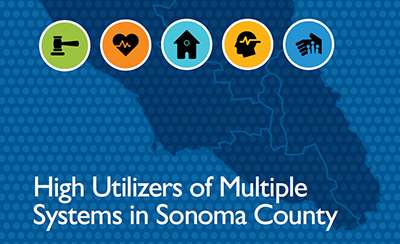- By:
- Category:

Sonoma County, CA July 7, 2020 — A new report released today by the California Policy Lab at UC Berkeley helps Sonoma County government leaders to identify and better serve a group of about 6,600 high utilizers of health, justice, and homelessness services provided by state and county agencies. These high utilizers represent approximately 1% of the county population, but account for an average of 26% of jail time, 28% of annual costs for behavioral health services, and 52% of nights in housing or shelters provided to the homeless.
The report focuses on government programs and services provided in five domains: physical health, behavioral health, housing, human services, and criminal justice. The research team worked with the county to link together anonymized records across county and state agencies, and then identified the highest utilizing “shared clients” between those systems. Providing services to the top 1% highest utilizers in Sonoma County cost the government at least $27,000 annually per person during the five-year study window.
“Almost half of high utilizers in Sonoma County don’t have stable housing, more than 6 in 10 have received services for substance abuse, and nearly two-thirds are interacting with the criminal justice system,” explains Evan White, executive director of the California Policy Lab and a co-author of the report. “These individuals have complex needs that are hard to identify by county staff working within only one domain, and our goal in partnering with Sonoma County is to help improve how these individuals receive care and services.”
“We have suspected for years that there is a shared population for whom the siloed, traditional government approach to providing services has not been effective. These high utilizers needed a new model of care that holistically addresses their needs across these siloed programs and services provided by the county and the community. The Sonoma County ACCESS Initiative is that answer. The findings of this report demonstrate that an integrated and collaborative service model is essential to not just get high utilizers into the safety net, but getting them out to improved well-being and greater self-sufficiency. We will be looking at other ways we can collectively work together to assist them,” said Sonoma County Department of Health Services and Community Development Commission Interim Executive Director, Barbie Robinson.
While utilization patterns varied, two sub-groups emerged among high utilizers:
• Group One (1,584 individuals): Justice-involved individuals with behavioral health issues and housing instability. These individuals spent an average of 56 days each year in homeless housing, more than three quarters had a history of alcohol abuse, and many struggled with other substances, including stimulants (55%), opioids (38%), and cannabis (16%). While these individuals averaged 41 days in jail each year, very few (9%) received new convictions during the five-year period, suggesting they were not always prosecuted for their arrest charges.
• Group Two (2,487 individuals): Individuals with serious medical conditions. This group of individuals who spent more than two days in the hospital per year on average incurred $39,800 in annual hospital charges and visited the emergency department 3.4 times per year. People in this group were less likely to interact with the criminal justice system or use homeless housing as compared to other high utilizers.
Recommendations: The researchers recommended strategies for the county to better serve high utilizers, including targeting coordinated care to highly vulnerable subgroups of high utilizers and identifying key points for intervention, such as when a person is leaving the criminal justice system.
Additional Background on ACCESS SONOMA: In 2017, Sonoma County began an effort to identify the most vulnerable county residents and improve coordination across agencies known as ACCESS Sonoma County (Accessing Coordinated Care & Empowering Self-Sufficiency) and this report will help inform that effort.
The California Policy Lab
The California Policy Lab creates data-driven insights for the public good. Our mission is to partner with California’s state and local governments to generate scientific evidence that solves California’s most urgent problems, including homelessness, poverty, crime, and education inequality. We facilitate close working partnerships between policymakers and researchers at the University of California to help evaluate and improve public programs through empirical research and technical assistance.
